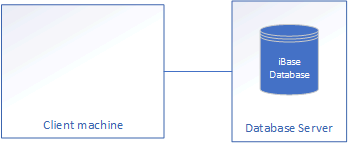SQL Server clients, servers, and networks
You can run iBase on a system configured in a number of ways.
- SQL Server database server for managing access to the databases
- iBase clients, or,
- An application server that is running iBase with thin clients, if you are using Terminal Services/Citrix
The following figures summarize the possible configuration options for iBase.
iBase Standard configuration option 1

iBase Standard configuration option 2

Hardware specifications and supported operating systems
Hardware specifications and the supported operating systems for a particular release of iBase are defined in its system requirements.Client machines
The client should be sized to suit all the applications that it is intended to run alongside iBase. Mapping products in particular can place heavy demands on the host’s processor and memory resources. The type of iBase usage that is expected on the client machine should also be taken into account: manual data entry places much lower stress on the client than analytical use or large data imports.
Server machines
iBase data is stored in database files that are managed by SQL Server. When your administrator first installs Microsoft™ SQL Server, they are prompted for the location of the program files and the data files. The default is that both sets of files are placed on the boot drive of the server. It is important to ensure that the data files are stored on the dedicated data partition. Typically this is a dedicated set of disks in a RAID 5 configuration. SQL Server stores the database files created by iBase in the default location for the database files.
We suggest that your SQL Server administrator use a RAID 1 configuration for the system disks and transaction logs, and RAID 5 for the data. The major activity in an iBase Standard installation is reading data and RAID 5 offers a performance advantage in reading. RAID 5 requires a minimum of three disks. The more disks used, the better the performance.
If the read auditing of activity is turned on, it is advantageous to place files for the iBase Audit Log database, both main data file and transaction log file, on a disk array with good write performance such as RAID 1. For maximum performance this should be on a separate disk controller.
